You're using an outdated browser. Please upgrade to a modern browser for the best experience.
Please note this is an old version of this entry, which may differ significantly from the current revision.
Subjects:
Art
William II of Hauteville King of Sicily (1171–1189). William II of Hauteville was the third king of the Norman dynasty on the throne of Sicily. He ruled independently from 1171 (from 1166 to 1171 he was under the regency of his mother) to 1189. From an iconographic point of view, he is particularly interesting because he was the first king of Sicily who made use of monumental images of himself. In particular, we have five official (namely, commissioned directly by him or his entourage) representations of him: the royal bull, the royal seal, and three images from the Cathedral of Monreale (near Palermo): two mosaic panels and one carved capital.
- royal images
- royal iconography
- kings of Sicily
- Norman dynasty
- William II of Hauteville
1. Introduction
William II of Hauteville was crowned king of Sicily in 1166, but at the beginning of his government, he was under the regency of his mother. It was from December 1171 that he ruled independently, and his reign lasted until 18 November 1189 (the day of his death) (in general, about William II of Hauteville king of Sicily see: [1,2]). He was the third Norman king of Sicily but, from an iconographic point of view, he was the first who did not limit his representation to seals and coins but made use also of monumental images of himself (for example, the Roger II’s representations in the Basilica of San Nicola in Bari and in the Church of Santa Maria dell’Ammiraglio in Palermo were not directly commissioned by the king. About the official images of William II’s Norman predecessors see: [3] (pp. 32–40 and pp. 51–52), with more details and previous bibliography). For this reason, he can be considered as the most representative of this royal family. Regarding him, we have five official (namely, commissioned directly by him or his entourage) representations: the royal bull and the royal seal and two mosaic panels and one carved capital at the Cathedral of Monreale (near Palermo) (about the identification of the William II’s official image see: [3] (p. 57)).
2. The Royal Bull
This artifact is a metal hanging seal with a diameter of 35 mm (Figure 1) (about this image see: [4] (p. 87), [5] (p. 100), [6]). On one face, there is the royal image with the inscription + W[ILLELMVS] D[E]I GRA[CIA] REX SICIL[IE] DVCAT[VS] APVL[IE] ET PRINCIP[ATVS] CAP[VE]. On the other face, there is the image of Christ identified by the monogram IC XC (namely, ΙHΣOΥΣ ΧΡΙΣΤOΣ NIKA: «Jesus Christ wins») and, again, the inscription + W[ILLELMVS] D[E]I GRA[CIA] REX SICIL[IE] DVCAT[VS] APVL[IE] ET PRINCIP[ATVS] CAP[VE]. The king is standing and, likely, he has a long beard. He wears Byzantine garments and symbols of power: a high and squared crown with lateral pendilia (probably a Plattenkrone), a cruciferous globe, a labarum, a tunic (a divitision or a skaramangion) and a loros intertwined in a T shape. This iconographic choice does not seem to have specific political and propagandistic motivations but simply follows the bull of his grandfather Roger II (and, probably, that of his father William I as well). Likely, its adoption was already decided during the regency period and, after that, it was used also for the whole of William II’s reign (about that see: [3] (pp. 35–37, pp. 51–52, and pp. 57–58)).
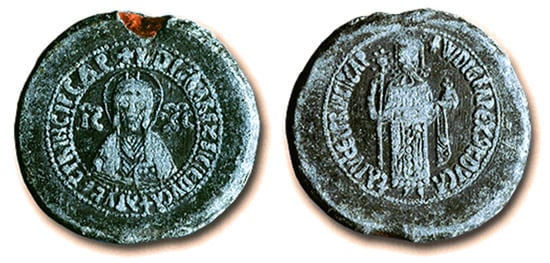
Figure 1. Bull of William II of Hauteville, obverse and reverse of impression on metal, March 1184. Palermo, Biblioteca Centrale della Regione Siciliana, Tabulario della Cattedrale di Monreale, diploma n. 50. Image published in: [3] (Figure 5).
Without a doubt, this image is an official representation of William II and, it mainly had a juridical function (it was used to corroborate the legal value of diplomas and documents issued by the royal chancellery). Its mobile support would have facilitated its circulation inside the Kingdom and, in this way, it could reach a large number of subjects. However, we should consider that seals were not made to move around but to be stored, with their documents, in the archives of their recipients. Moreover, their dimensions were somewhat reduced and certainly of scarce visual impact. Finally, their use was not particularly common either. Indeed, we should note that the average number of issues does not seem to be very high during William II’s reign (even if, greater than that of his two predecessors) (about the number of issues of the William II’s chancellery see again: [3] (p. 58), with more details and previous bibliography). If we also consider that the same recipients could receive several documents, we can suppose that the number of subjects involved was not particularly abundant and limited at the aristocratic and ruling class of Southern Italian society. Therefore, in line with these data, it was not very frequent to be able to see the royal image of the bull and only a limited number of people would have had this opportunity.
3. The Royal Seal
This artifact is a red wax hanging seal of 55 mm of diameter placed in a wooden box of 65 mm in diameter (Figure 2) (about this image see: [4] (pp. 86–87), [5] (p. 90), [6,7] (p. 204), [8]). The legend has the inscription + W. [ILLELMVS] DEI GRA[TIA] REX SICILIE DVCATVS APVLIE ET PRINCIPATVS CAPVE and, around the royal image it is written W[ILLELMVS] REX. The king wears, again, Byzantine garments and symbols of power: a high and squared crown with lateral pendilia (probably a Plattenkrone), a cruciferous globe, a labarum, a tunic (a divitision or a skaramangion) and a loros. However, here there are two important changes: the loros is not intertwined in a T but in a Y shape and, the ruler is not standing but sits on a throne (unfortunately, it is not possible to clearly understand if the king is shaved or has a more or less long beard). It is difficult to say if the concepteur was following a specific pattern and if these iconographic choices had precise meanings. In Byzantine bulls and seals, in general, it is present the loros in a T shape and the ruler is standing. Moreover, also in the Norman tradition there is nothing similar. In terms of the commission, dating, function, visibility and fruition, the previous considerations on the bull are valid also for the seal. Hence, it seems likely that it was not very frequent to be able to see the royal image of the seal and only a limited number of people of the Sicilian Kingdom would have had this opportunity. However, we would like to note that the use of this object was probably limited to the royal mandates and thus, in consideration of the surviving documents of the royal chancellery, lower in comparison with that of the bull (even if mandates could have paid more losses than royal diplomas) [3] (pp. 57–58).
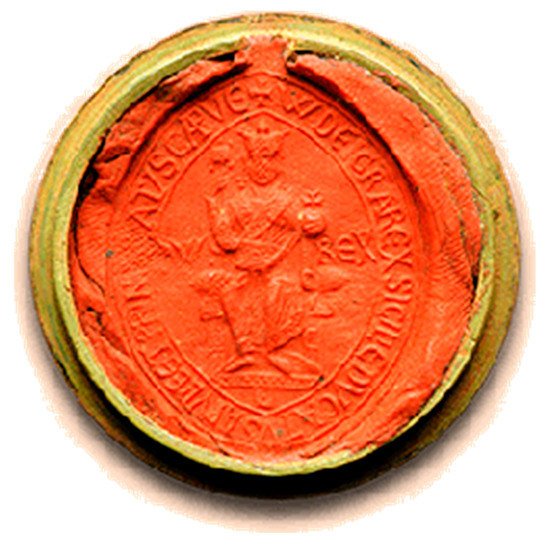
Figure 2. Seal of William II of Hauteville, impression on red wax, 15 April 1172. Palermo, Archivio Storico Diocesano, Tabulario della Cattedrale, diploma n. 22. Image published in: [3] (Figure 6).
4. The Mosaics of the Cathedral of Monreale
The architectural structure of Monreale is composed of a cathedral, a Benedictine monastery and a sort of royal palace and, it had function as a regal church and pantheon for the royal family. Construction begun in 1172 and finished in 1186 (when Bonanno of Pisa concluded the bronze doors of the main entrance) (about the architectural complex of Monreale see: [9,10] (pp. 91–177), [11,12,13] (pp. 51–73), [14,15]). Recently, Thomas Dittelbach proposed that the internal decoration was concluded for William II and Joan of England’s wedding in 1177 but, Sulamith Brodbeck has highlighted that some elements of the iconographic program are related with historical and political events included in the period between 1177–1183 [14] (pp. 126–127), [15] (pp. 24–25 and pp. 192–195), [16]. Probably, it was completed only during the 1180s and, hence, the two royal representations were likely conceived and manufactured between 1177 and 1183 (or shortly after).
King William II directly founded the architectural complex of Monreale together with the approval of the papacy. For this reason, we can consider the two mosaic panels with the royal image official representations of him (about these two images see: [7] (pp. 202–204), [10] (p. 123 and pp. 302–304), [13] (pp. 64–72), [14] (pp. 308–319), [17] (pp. 50–52), [18] (pp. 108–109), [19] (p. 192), [20,21,22,23] (pp. 204–209)). They are on the eastern arch of the presbytery of the Cathedral. The image on the left pillar represents Christ in his majesty while He is crowning William II with the help of two angels, who are bringing labarum and globe from Heaven (Figure 3). The monogram IC XC identifies the first, while the inscription REX GVILIELMVS S[E]C[VN]D[VS] identifies the second. Between the two images is written MANVS ENI[M] MEA AVXILIABITVR EI in order to underline the close relationship between Christ and William. This sentence comes from the Old Testament and, it refers to the promise by God to David through the prophet Nathan and, it alludes to David’s coronation as king (“Tunc locutus es in visione sanctis tuis, / et dixisti: Posui adjutorium in potente, / et exaltavi electum de plebe mea. / Inveni David, servum meum; / oleo sancto meo unxi eum. / Manus enim mea auxiliabitur ei, / et brachium meum confortabit eum” (italics is our): [24] (Sl 88, 20–22)). The image on the right pillar, instead, represents King William II’s offering, as founder, of the model of the Cathedral of Monreale to the Virgin sitting on throne while the Hand of God is blessing the scene from Heaven and two angels are flying down to collect the gift (Figure 4). The monogram MP ΘΥ (namely, MHTEP ΘEOΥ, «Mother of God») identifies the Virgin while the inscription REX GVILIELMVS S[E]C[VN]D[V]S distinguishes, again, the king.
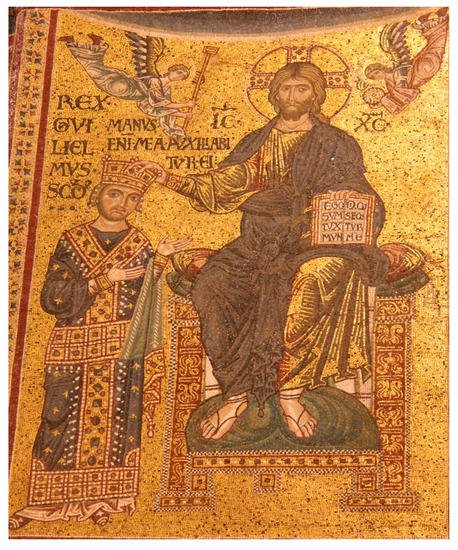
Figure 3. Christ crowning William II of Hauteville, mosaic, 1177–1183. Monreale, Cathedral, Presbytery, Choir. Photo taken by author.
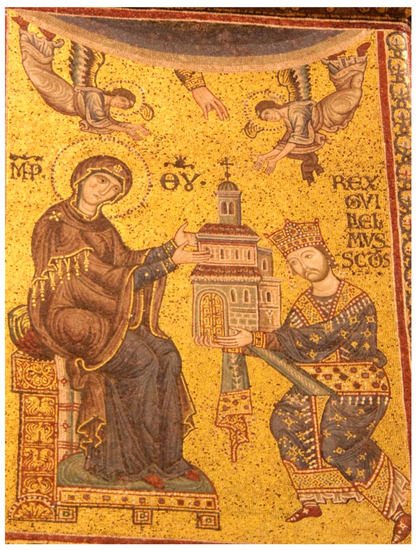
Figure 4. William II of Hauteville offering the Cathedral of Monreale to the Virgin, mosaic, 1177–1183. Monreale, Cathedral, Presbytery, Choir. Photo taken by author.
In both of the panels, William II is represented standing in an act of respect towards the Divinity. He has long (but not very long) hair and a short and light brown beard and he is, again, wearing Byzantine garments and symbols of power: a high and squared crown with lateral pendilia (probably a Plattenkrone), a divitision, a skaramangion and a loros intertwined in a Y shape. Everything is completely decorated with pearls and precious stones and, the tunic has geometrical embroideries that may represent stylised stars. If the references to the Byzantine iconographic traditions are evident, it is difficult to understand if the concepteur was following a specific figurative pattern. However, if the type of crown and the loros in a Y shape were no longer in use in Byzantium during the 12th century, we can find them in the Roger II’s mosaic in the already quoted Church of Santa Maria dell’Ammiraglio in Palermo. Probably, as for the bull, the mosaic was more or less imitating the Norman figurative tradition in rendering the details of the royal image [3] (pp. 58–62).
In terms of collocation and visibility, as said, our pictures are respectively on the left and right pillar of the eastern arch of the presbytery. It is the one that divides the choir from the main apse of the cathedral. Hence, we are in the presbytery area and close to the main altar. Above, along the edge of the arch, there are biblical figures and around them images of saints. Under the two mosaics, there are the royal (north side) and episcopal (south side) thrones (the real presence of an episcopal throne in this place is dubious, see: [10] (p. 106), [14] (p. 144 and pp. 286–287), [23] (p. 209, note 23), [25] (p. 238). However, Sulamith Brodbeck has recently considered it possible, see: [15] (pp. 183–184), [16]). Therefore, this means that our representations are situated in a very symbolic place and, it is considerable that they present monumental dimensions, particular attention for iconographic details and placement in a not very high position (hence, not far from their beholders). But, notwithstanding, they have a very reduced visibility. Indeed, they are not turned towards the aisles but to the choir and only the officiating clergy could see them. Moreover, originally, a nearly four-meter high gate divided the aisles (reserved to the faithful) from the choir (reserved to the ecclesiastics) (about this sort of rood screen see: [15] (pp. 186–187), [26] (pp. 115–119)). In other words, only the ecclesiastics and monks of Monreale could see the images and they were associated to a purely liturgical context.
From the point of view of function, these mosaics have been interpreted as Herrscherbilder, namely, as political images created to celebrate and legitimate the royal power. In particular, the one with the divine coronation scene has been read as the visual transposition of the concept of the divine origin of the monarchical power (king as a Deo coronatus) and, it its aim has been underlined to completely identify William II with Christ. However, considering that these images had a purely religious fruition and, in consideration that they were placed close to the main altar, also a specifically liturgical use, recently it has been proposed that their function was probably connected more with worship and royal devotion than with the staging of political authority [27] (pp. 81–128), with more details about previous bibliography and this new interpretation]. Indeed, this would have been in tune with the whole ecclesiastical structure that, as stated in a royal diploma issued on 15 August 1176, the king wanted “ad illius [namely, to God] ergo laudem, honorem et gloriam” [28] (diploma n. 89, ll. 14–15) in thanksgiving for the benefits received and he endowed it in order that its monks “Deum nobis [namely, William II himself] implorent propicium” ([28] (diploma n. 89, ll. 40–41, but similar aspects are also in diploma n. 102)). Furthermore, this would have been in tune with the whole mosaic decoration of the Cathedral that, from a theological point of view, was fully focused to the liturgical destination of the church [29,30,31,32].
This interpretation finds confirmation also in the historical and political context in which the mosaics were conceived. Indeed, the period after 1177 was particularly stable from a political point of view: William II had been ruling for several years (from 1166 under the mother regency and from 1171 independently) and his authority was undoubted; in this period, there were no particular internal tensions; the relationships with the papacy were good; the Byzantine emperors ceased to try to reconquer Southern Italy; the relationships with the German Empire were increasingly improving (about this historical and political context see: [33] (in particular on the period 1177–1186 see pp. 446–451). This text can be integrated with: [34,35]. Specifically for William II’s reign see: [1,2]). Moreover, considering the connection of the mosaics with the clergy and the abbot-archbishop of Monreale, we have to note that the latter were closely related to the Norman court and its king and, they had no interest in doubting his authority (about the relationship between William II and the abbot-archbishop of Monreale see: [15] (p. 141)). In the absence of a political interlocutor, it seems impossible to talk about a political and propagandistic function for our mosaics. Furthermore, considering that the Kingdom of Sicily was formally a papal fief, it appears odd that William II decided to present himself crowned by Christ and not by the pope to legitimate his power (especially in a place founded, as said, with the approval of the papacy) (about that see again: [27] (pp. 81–128)).
These considerations have led to a review of the meaning of the two mosaics in the function of thanksgiving and devotion toward God. Probably, on one pillar, there was William II’s tribute to God who gives him the Sicilian crown and His protection and, on the other pillar, the same monarch who donated the very church of Monreale to the Virgin and God in reward and gratitude for what he had received from them in the hope of saving his soul and reaching the Kingdom of Heaven.
5. The Capital of the Cathedral of Monreale
The cloister of the Cathedral of Monreale has a square shape of 47 m on each side with 228 small columns decorated with 104 double capitals and five quadruple capitals (about the cloister of the Cathedral of Monreale see: [12,36,37,38,39,40]). The iconographic program is quite varied and disorganic. It is composed of vegetal and ornamental elements; mythological, allegorical, and hagiographical themes; scenes of the Old and New Testaments. William II’s image is on the south face of the eighth capital of the western side (about this image see: [7] (p. 204), [17] (p. 54), [23] (pp. 209–212), [37] (pp. 143–146), [41,42]). As a mosaic, it is plausible that the king commissioned it and that it dates between 1177–1183 (or shortly after). The capital is 40 cm high and 65 cm wide and, therefore, the royal image, although well detailed and not far from the ground, has a reduced visual impact in comparison with the two monumental mosaic panels in the Cathedral (Figure 5). Moreover, in consideration of its collocation, we can argue that only the ecclesiastics and monks of Monreale were able to see it.
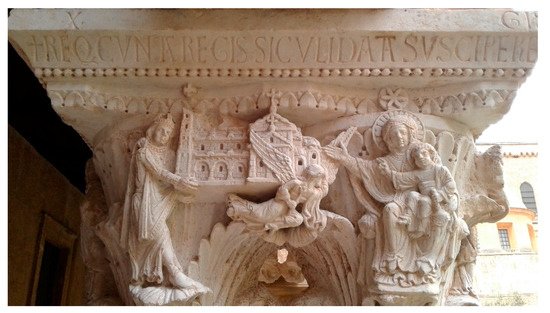
Figure 5. William II of Hauteville offering the Cathedral of Monreale to the Virgin, carved capital, 1177–1183. Monreale, Cathedral, Cloister. Photo took by author.
The scene represents the king as founder, offering the model of the Cathedral of Monreale to the Virgin with the help of an angel. However, the inscription engraved on the upper edge of the capital (+ REX Q(UI) CUN(C)TA REGIS, SICULI DATA SUSCIPE REGIS) clarifies that the real recipient is Christ, who is on the Virgin’s knees and He is blessing the royal act. On the other faces of the capital, there are four allegorical figures (easily identifiable thanks to inscriptions): the Justice (+ IVSTITIA DOMINI), the Charity (+ DEVS CARITAS EST), the Hope (SPES) and the Faith (FIDES). Between the last two, there is a lamb with a cruciform aureole. It is the Christ, identified through the inscription: + [H]IC D[OMI]N[U]S MAGNVS LEO CRISTVS CERNITVR AGNVS. The capital is stylistically connected with southern France sculpture and, iconographic similitudes have been found in the main portal of the Cathedral of Santa Maria Matricolare in Verona and in the front porch of the Basilica of San Prudenzio in Armentia. The royal figure is standing and has long (but not very long) hair and a short beard. Garments and symbols of power differ from those of the mosaics. In particular, here the king wears a broad cloak and a crown with crossed arches (Bügelkrone) and pendilia. It seems that they refer to a Western iconographic tradition rather than a Byzantine practice [3] (pp. 62–63).
Historians have, in general, pointed out the celebrative function of this royal image. In other words, it would have celebrated the king and his virtues and it would have strengthened the close relationship between William II and Christ in order to legitimate the Norman power on the Sicilian throne. However, recently, this interpretation has been questioned in consideration of the context of where this image was placed. In particular, we have to consider that it was in a monastic cloister and, hence, it was visible only to the ecclesiastical members of Monreale. As previously pointed out, they were closely related to the Norman court and its king and they had no interest in doubting his authority [about the relationship between William II and the abbot-archbishop of Monreale see again: 15 (p. 141)]. Moreover, the period after 1177 was particularly stable for the Kingdom and the royal authority was more or less undisputed [about this historical and political context, in particular, see again: [33] (pp. 446–451). For these reasons, it seems more likely that the image had a religious (and not political) function, connected with the ecclesiastical activities performed in this place. As already noted, in the diploma issued on 15 August 1176, William II endowed the Cathedral of Monreale in order that its monks dedicated themselves in praying to God in favour of the king and his soul [28] (diploma n. 89, but similar aspects are also in diploma n. 102) Although the cloister was not used for official liturgy, in this space, monks could personally meditate and pray. In this sense, the royal image probably played a mnemonic role: it reminded the religious of Monreale of the founder of the monastery in order to stimulate and raise prayers in favour of his soul. In this iconographic reading, the allegorical images of the virtues plausibly represented the gifts that William II aimed to achieve from God thanks to the offer of the Cathedral and the pleas of the monks [about this interpretation see again: [3] (pp. 63–65). In other words, this image was also connected with the devotional aims of the Norman king and his personal hopes of saving his soul and reaching the Kingdom of Heaven.
6. Conclusions
In order to summarise the general line of the William II of Hauteville’s iconography, we can conclude that this king did not make particularly abundant use of his images but, in the panorama of the Norman kings of Sicily, he introduced important innovations about the media utilised. On the one hand, he avoided the use of his representations on coins but, on the other hand, he did not limit his image to bulls and seals but he adopted also monumental representations of himself. In particular, he commissioned royal images in mosaic and sculpture for a religious location: The Cathedral of Monreale (more specifically, for its presbytery area and its cloister). However, although these images had a monumental nature, particularly attention to the rendering of the iconographic details and a greater visual impact in comparison with bulls and seals, they were in restricted areas where, in general, only the religious member of Monreale could have access. For this reason, they were presumably addressed only to religious beholders and they did not play a political role or were not part of a specific strategy of usage of the royal image for government purposes. In conclusion, they possessed only religious and devotional meanings and functions and were related more with a sort of private (rather than public) sphere. Certainly, bulls and seals had a greater circulation and, they could reach a wide part of population. However, their images had little sizes, every detail of the royal image was less visible, and their use did not seem to be particularly frequent during William II’s reign (and, in any case, limited at the governing class). The iconographic themes adopted in these artefacts present William II seated on the throne, crowned by Christ and as a donor of gifts towards Christ or the Virgin. In the rendering of the royal image (and the related symbols of power, attires and physical features), these representations followed, more or less, the iconographic tradition of the Byzantine emperors already adopted by the Norman predecessors. However, there are also important variations. The position on the throne, the not very long hair, the short beard, the broad cloak and the Bügelkrone took the distance from the previous figurative royal patterns. Nevertheless, it remains doubtful if, in this way, the king wanted to express specific messages or if he simply seconded the skills of the craftsmen involved in their realisation.
This entry is offline, you can click here to edit this entry!
